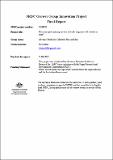| Abstract | This project set out to test the suitability of new technology for precision herbicide application in sugarcane. WeedSeeker® sensors have been successfully used in broadacre situations; with individual case studies reporting herbicide reductions of more than 80%. Since most sugarcane fields have patches of grass and weeds, along with large areas that are weed-free, this technology offers an opportunity to reduce input costs and reduce our environmental footprint. Our trial results showed that the WeedSeeker® sensor technology can work successfully in sugarcane crops. The WeedSeeker® technology did reduce herbicide usage and, just as importantly, it detected weeds and effectively sprayed them. Savings in herbicide usage will vary from field to field, depending on weed pressure. Obviously the fewer the weeds the more savings will be made. Despite problems with the crop deflectors, the trials consistently showed herbicide usage of less than 50% compared to the standard GC shield, which sprayed the entire target area. Apart from the obvious saving in herbicide costs, other significant benefits of reduced labour, through reduced fill-ups as one tank will cover at least twice or three times the area, and larger areas able to be sprayed per day providing more timely weed control, should also be realised. A simple economic study which only considered the herbicide cost saving, and not benefits from lower labour costs or the benefit to cane yield through more timely weed control, was undertaken. It is more likely that large farmers, or spray contractors, would be able to justify the cost to purchase the equipment. The longer payback period for a farmer with a small area may deter them from making the investment. One of the benefits arising from the early modifications to the spray rig design, and sensor placement, was to reduce the number of WeedSeeker® sensors per shield from four to three. Clearly, the group under-estimated the effort required to modify the shields and crop deflectors. The current design of the crop deflectors is forcing a small number of cane leaves under the shield, and, as such, the WeedSeeker® sensors turn on herbicide at the wrong time. However, the group feels this is a problem than can be rectified and does not detract from the effectiveness of the precision technology. |

